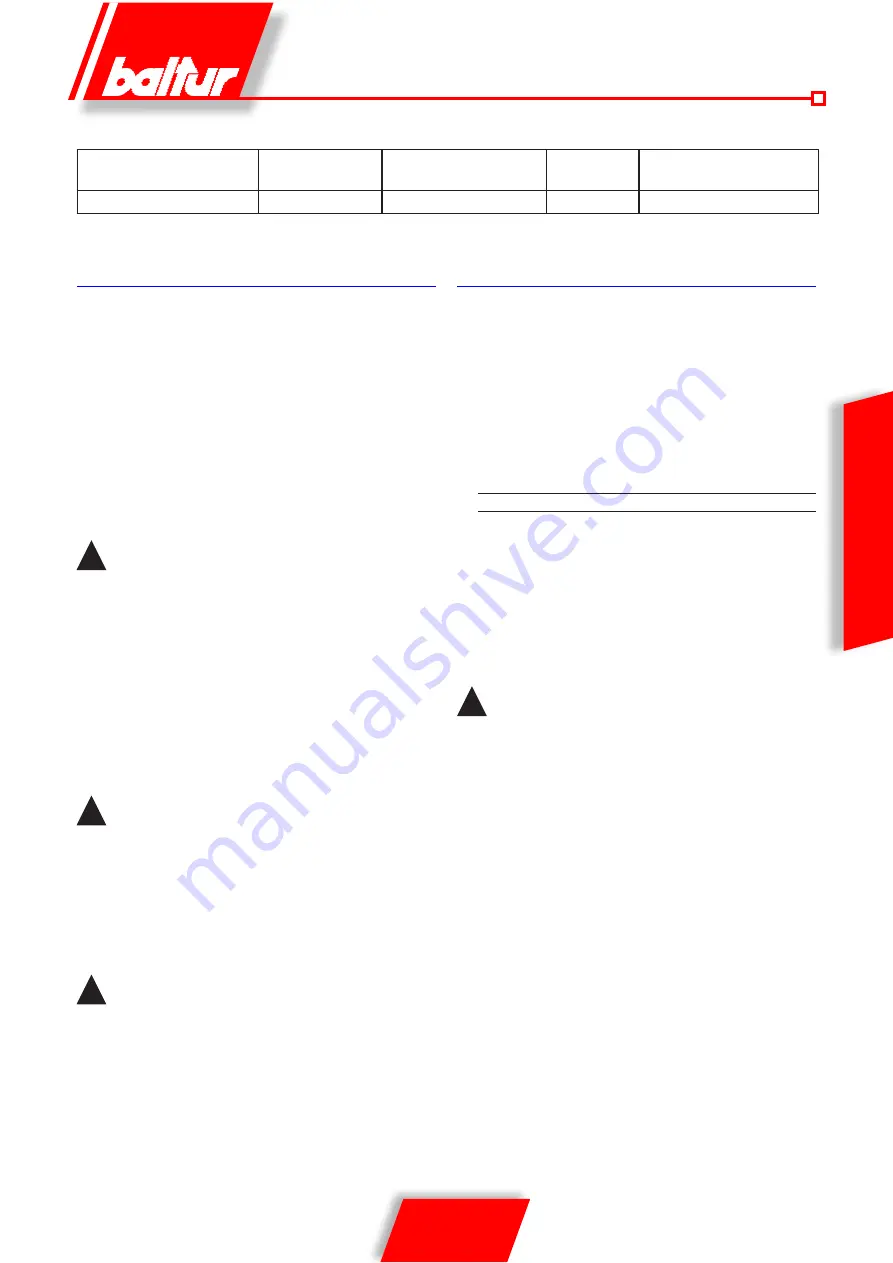
15 / 28
0006081325_201210
ENGLISH
FIRST FILLING UP OF PIPELINES
After making sure that protective plastic caps inside the pump fittings
have been removed, proceed as follows :
• Set the burner switch on “0”.This operation prevents automatic
connection of the burner.
• With a three-phase burner make sure that the motor rotates
counter-clockwise, looking at the burner from the pump end.
The direction of rotation can be determined by observing the
direction of rotation of the fan through the port-hole on rear of
the fan scroll. To start the motor, close the remote control switch
manually (pressing on the mobile part) for a few seconds and
watch the direction of the rotation of the fan. Of it is necessary
to reserve the direction of rotation, invert two phases on line
input terminals counter motor K1
!
To positively determine the direction of rotation, wait until
the fan turns very slowly because it is quite possible to
misinterpret direction of rotation.
• Disconnected, if already connected, the flexible pipes from both
suction and return lines.
• Dip the end of the suction flexible pipe into a vessel containing
either lubrification oil or fuel oil (do not use low viscosity products
such as gas-oil, light oil, kerosene. etc).
• Now press on the mobile part of the motor remote control switch
to start up the motor and the pump. Wait until the pump has
sucked in an amount of lubrificant equal 1 or 2 glasses, then
stop. This operation will prevent the pump from operating dry
and will increase the suction power.
!
Pump operating at 2800 r.p.m. must not work dry otherwise
they will jam (seizure) within a very short time.
• Now connect the flexible pipes to the suction line and open
all the gate valves fitted on this line and any other similar fuel
cut-off device.
• Now press again on the mobile part of the motor remote
control switch to start up the pump which will suck fuel from the
tank. When fuel is seen coming out of the return line (not yet
connected), stop.
!
:
If the pipe is long, it may be necessary to bleed the air out
through the cap; if the pump is not fitted with a breather cap,
remove the cap from the pressure test point.
• Connect the return flexible pipe to the return line and open the
valves fitted in this pipe. Now the burner is ready for lighting up.
STARTING UP AND REGULATION
Before starting up the burner make sure that :
• Feeding line connections to thermostats or pressure switches are
made exactly according to electric diagram of the control box.
• Check if there is fuel in the tank and water in the boiler.
• All the gate valves fitted on the fuel oil suction and return pipes
should be open; the same thing applies to any other fuel cut-off
device.
• Make sure that discharge of combustion products takes place
freely (boiler and chimney gate valves open).
• Make sure that burner head project into the combustion
chamber according to the manufacturer’s directives.
For compliance with this requirement, the burner is equipped
with a boiler mounting flange, which slides in respect to the
combustion head.
• The nozzles fitted on the burner should match the boiler
capacity but, if necessary, replace them with others.
Under no circumstances should the amount of delivered fuel
be higher than the maximum amount required by the boiler and
the max. amount permitted for the burner. To start the burner
proceed as follows:
!
The burners in TBL version are provided with switch to change
from 1
st
to 2
nd
stage.
• Avoid working with the second flame: position the 1
st
and 2
nd
stage switch on the printed circuit at its 1
st
stage position for
burners.
• Slightly open the air regulator and let in an
amount of air deemed to be necessary for burner
operation with the 1
st
flame and fix it in this position:
- for adjustment of the hydraulic jack see 0002935420,
- for adjustment of the servomotor see 0002935210.
Set the air control device in an intermediate position on the
combustion head (see the chapter “Air control on the combustion
head”).
• Close the isolating switch and control box switch.
• The small motor of the cyclic relay which will start to rotate
causing the connection of the burner component devices
according to the preset program. The burner will start operation
as described in the Chapter “Description of Operation”.
• When the burner operates with the 1
st
flame, adjust the amount
of air necessary,for an efficient combustion by following the
previous description under n. 2. It is better if the amount of air
for the 1st flame is slightly reduced in order to ensure a perfect
ignition also in the most critical conditions.
• After adjusting the amount of air for the 1
st
flame, stop the
burner by cutting off the current from isolating switch, connect
the terminals on the terminal board of the 2
nd
flame thermostat
among them and settle the 1
st
and 2
nd
stage switch in 2
nd
stage
Control box specifications
Control box and relativ
programmer
Safety time
in seconds
Preventilation and washing
time in seconds
Post-starting
in seconds
`time between 1st e 2nd flame
in seconds
LMO44
5
25
5
5
Summary of Contents for TBL 105P
Page 2: ......
Page 26: ...26 28 0006081325_201210 ENGLISH ELECTRIC DIAGRAM ...
Page 27: ...27 28 0006081325_201210 ENGLISH ...
Page 52: ...26 28 0006081325_201210 ESPAÑOL ESQUEMA ELECTRICO ...
Page 53: ...27 28 0006081325_201210 ESPAÑOL ...
Page 78: ...26 28 0006081325_201210 FRANÇAIS SCHEMA ELECTRIQUE ...
Page 79: ...27 28 0006081325_201210 FRANÇAIS ...
Page 104: ...26 28 0006081325_201210 DEUTSCH SCHALTPLAN ...
Page 105: ...27 28 0006081325_201210 DEUTSCH ...
Page 107: ......











































